Electrically Conductive Polymer Composites
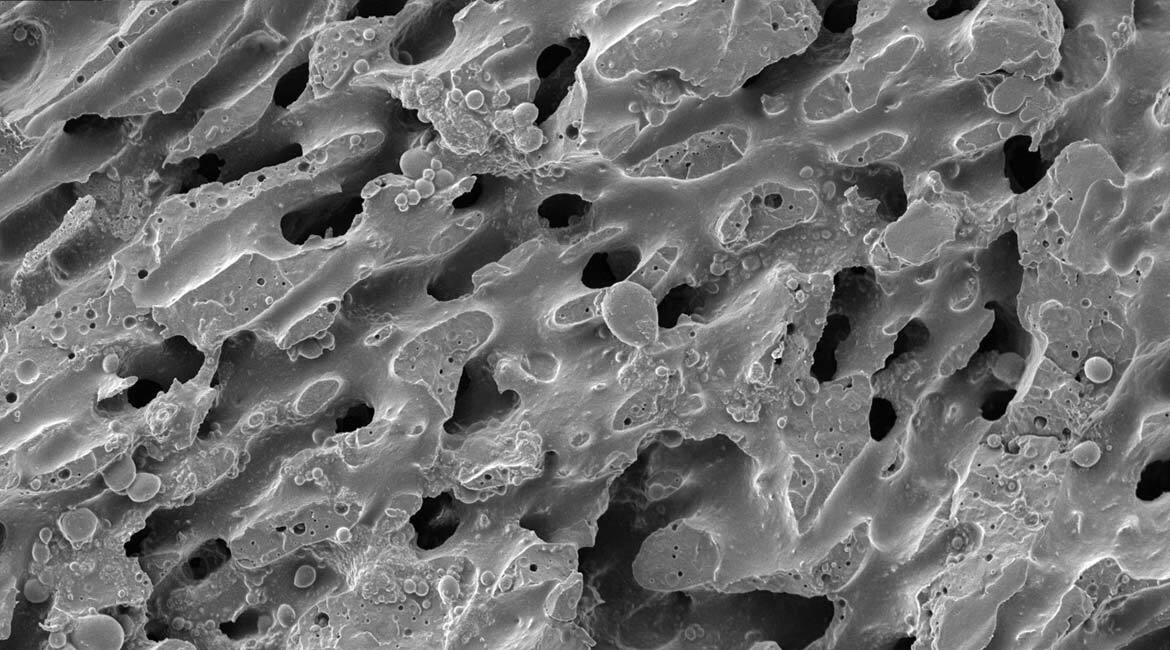
SEM picture of polypropylene/polystyrene/carbon nanotubes. CC License.
Polymers are widely used in many objects in our daily lives. They are amazing materials with unique characteristics—flexible, lightweight, and cheaper to produce than most other materials. However, polymers generally do not conduct electricity, which sometimes limits their potential range of applications in areas that include robotics, flexible electronics, intelligent medical devices, and energy harvesting where electrically conductive polymers could be successfully used.
Reducing the Percolation Threshold Concentration
To overcome this limitation, electrically conductive nanoparticles—with at least one of their dimensions ranging from 1 nm to 100 nm—can be mixed with polymers during processing. The most commonly used nanoparticles are carbon nanotubes, carbon black, and graphene. For the material to conduct electricity, an optimal concentration of filler should be added to the polymer. Indeed, a conductive network of particles must be formed within the polymer matrix, such as the one shown on the right side of Figure 1. Specifically, when the electrical conductivity of a polymer composite is measured as a function of filler concentration, a graph similar to the one presented in Figure 1 is obtained by plotting the electrical conductivity on a log scale. For low filler concentrations, the particles will not touch each other, and the material will present dielectric (non-electrically conductive) properties (left side in Figure 1). Once the concentration of particles increases to a critical value, electrical conductivity will increase by several orders of magnitude (~10 orders of magnitude) (pink zone in Figure 1). This increase of material property is spectacular; it could be compared to the density of a tennis ball increased by the same 10 orders of magnitude, where the ball would weigh as much as three fully loaded Boeing 747.
The concentration at which this phenomenon occurs is known as the percolation threshold concentration, PTC. Above the PTC, the material is considered electrically conductive. For economic reasons and in order to maintain the desired mechanical properties of the material, the PTC must be decreased as much as possible.
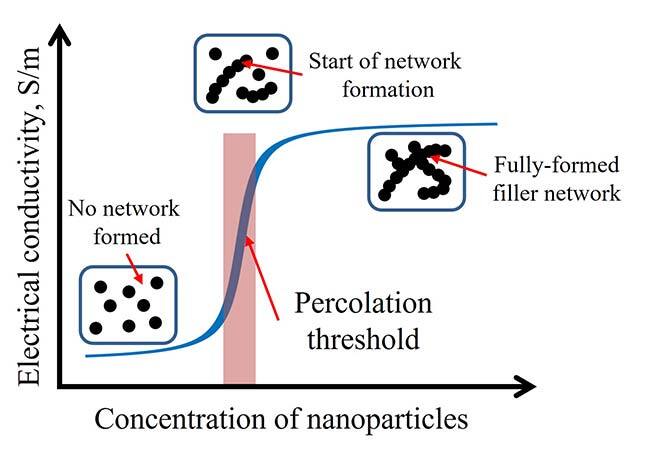
Figure 1 — Schematic illustration of the percolation threshold principle.
Obtaining a Co-Continuous Morphology
An innovative way to reduce the percolation threshold is to mix one polymer to which conductive nanoparticles have been added with another polymer with no added nanoparticles. The mixture of two or more polymers is called a blend, and under precise processing conditions, a co-continuous morphology—such as the one featured in Figure 2—will be obtained. This will result in a reduction in PTC.

Figure 2 — Co-continuous morphology achieved by mixing two polymers.
Unfortunately, there is only one way to find these “precise processing conditions” for a co-continuous morphology creation during melt-mixing. It means trying out a lot of parameters, involved in the melt-mixing process, such as temperature, time and speed of mixing, torque, and so on. As a result, if the structure shown in Figure 2 is obtained, it may be unstable when further processed. Indeed, the designed material is expected to be molded to form different objects.
Impact of Deformations on Co-Continuous Blends
In this work, we studied the structural evolution of electrically conductive blends, presenting a co-continuous morphology, when subjected to different deformations—with different processing conditions—that normally occur during polymer processing. For this, we used rheology, the study of flow of matter. In essence, rheology was first used as a tool to characterize the co-continuous morphology of conductive blends, then to subject the material to deformation and characterize again its morphology following the logic depicted in Figure 3. For this, we developed a model that correlates the morphology of co-continuous blends to its rheological characterization.

Figure 3 — Experimental protocol
Figure 4 shows the typical co-continuous morphology of a conductive composite. The morphology of the blend was analyzed using scanning electron microscopy (SEM) and a parameter known as domain size, defined by:

Where is the total area of the SEM image and is the interface length between two polymers estimated using a homemade image analysis script. The domain size was found equal to 1.31 µm.
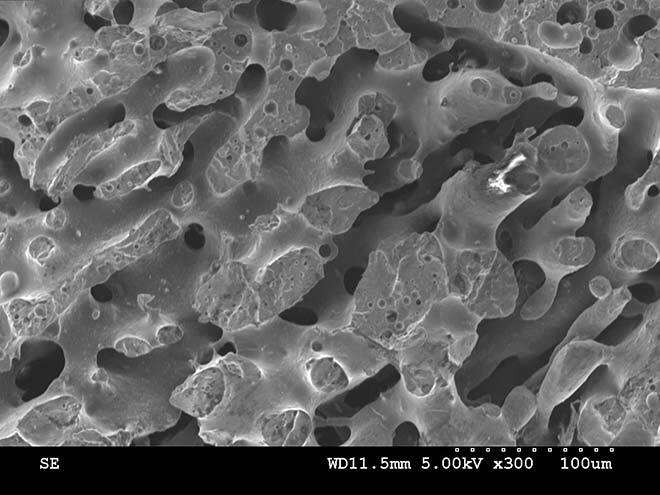
Figure 4 — SEM picture of polypropylene/polystyrene/carbon nanotubes (PP/PS/MWCNT) composite with a 50/50/0.5 wt.% of components. Polystyrene was extracted from the matrix, to better visualise the co-continuous morphology.
Figure 5 shows the rheological characterization of the blend whose structure is featured in Figure 4. The symbols represent the experimental data, whereas the line represents the developed model. We can see that a good fit resulting in a value of domain size of 1.5 µm was obtained, which validates our model.
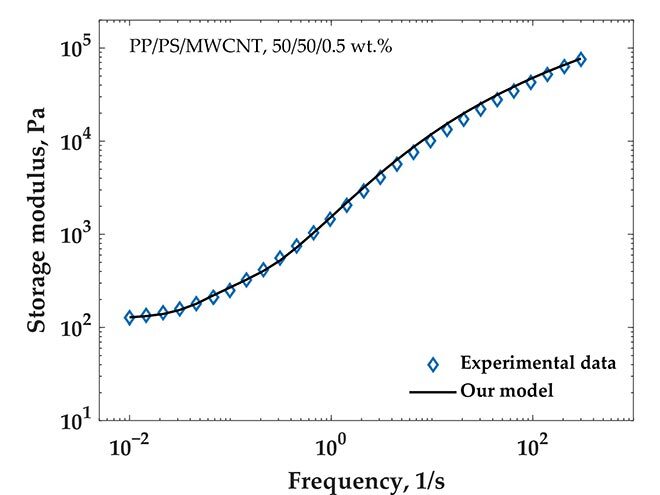
Figure 5 — Storage modulus as a function of frequency for PP/PS/MWCNT composite including 0.5 wt.% of MWCNT (symbols) with model data representing the fit of the developed model (line).
Figure 6a shows the rheological characterization and developed model fit of the blend whose structure is featured in Figure 4 after deformation. We can see that the developed model adequately describes the experimental data for the composite after the applied deformation. This model fit resulted in a domain size value of 5.5 µm, where the morphology coarsened after applied deformation can clearly be seen in Figure 6b — SEM picture of PP/PS/MWCNT composite with 50/50/0.5 wt.% of components after deformation.
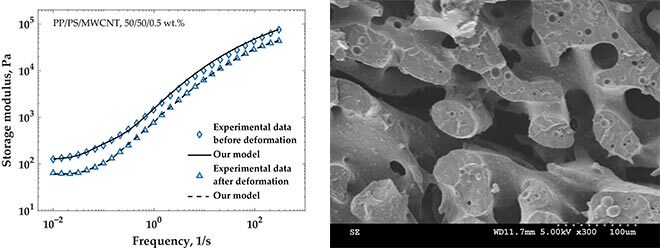
Figure 6 — a) Storage modulus as a function of frequency for PP/PS/MWCNT composite with 0.5 wt.% of MWCNT (symbols) with model data representing the fit of the developed model (line) before and after applied deformation; b) SEM picture of PP/PS/MWCNT composite with 50/50/0.5 wt.% of components after applied deformation. Polystyrene was extracted from the matrix to better visualise the co-continuous morphology.
Conclusion
The model, as well as the experimental protocol developed in our work—published in the reference below—helps to characterize the morphological evolution of electrically conductive composites and to predict the behavior of these types of materials during applied deformation. This makes it possible to produce flexible and lightweight electrically conductive polymers, with good mechanical properties, at low costs. Such materials have a promising future in various industrial applications.
Additional Information
Please see the following paper for further information:
Strugova, D., É. David, and N.R. Demarquette, Linear viscoelasticity of PP/PS/MWCNT composites with co-continuous morphology. Journal of Rheology, 2022. 66(4): p. 671-681.



